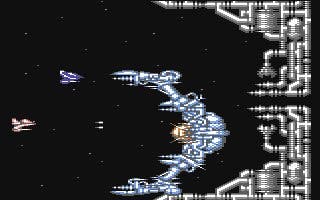Armalyte
I can't believe it's not Arma.
The surge of titles appearing in the arcades continued through the 1980's with each new game intent on pushing the boundaries of technology; offering the player increasingly challenging and graphically rich games to play. The 8-bit computers could only look on with a glint of envy in their digital eye.
Thalamus was proving to be the developer of choice on the Commodore 64, delivering one quality game after another. The idea for Armalyte was conceived independently of their other games but it was eventually announced by Thalamus that this was the follow up to its previous title, Delta.
The influence of R-Type - a title that had reigned supreme in the arcades the previous year - shone through in the design of this side scrolling shooter and was indeed the closest a C64 gamer could possibly get to have their very own R-Type cabinet in their bedroom.
Zzap! 64 loved the game so much that they awarded it a "Gold Medal", Thalamus' first accolade from the magazine and many other publications followed suit with their praise.
Graphically, Armalyte is staggeringly good with a science fiction theme applied throughout the design of the sprites and backdrops. The customary soundtrack was done by acclaimed SID musical maestro Jeroen Tel that added greatly to the overall atmosphere.

The gameplay meets the high visual and audio standard set whether playing in either single or two player mode. The action is exhilarating as swarms of enemies launch themselves towards your ship in pre-determined paths, while avoiding the static architecture can be immensely challenging as the playing area has to be continually scanned for the incoming bad boys. If you find yourself in the wrong place at the wrong time, you invariably lose a life as you smash into the metallic structures.
Armalyte was the title that brought the 8-bit Commodore 64 computer closer to the arcade experience than had previously been seen. Possibly Thalamus' most defining release.
